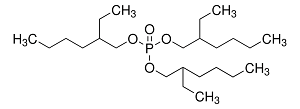Trioctyl Phosphate

Product Description
Trioctyl phosphate (TOP) is a versatile compound with various industrial applications due to its unique properties.
Product:
Trioctyl Phosphate
CAS:
78-42-2
Synonym:
Tris(2-ethylhexyl) phosphate; Phosphoric acid, tris(2-ethylhexyl) ester
Structure:

Typical Characteristics
Appearance
Clear colorless to pale yellow liquid
Boiling point
215 °C/4 mmHg
Density
0.924 g/cm3
Melting point
-74 °C
Molecular Weight
434.63
Odor
Slight sharp odor
Purity
97%
Refractive index
1.444
Uses, Applications & Markets
Key applications
get a quote
We Offer Trioctyl Phosphate
in various grades
A few of the grades available are listed below:



Trioctyl Phosphate used in many
industry applications
Trioctyl phosphate (TOP) is a versatile compound with various industrial applications due to its unique properties. Here are some of its key uses:
- Plasticizer: TOP is commonly used as a plasticizer in polymer formulations, particularly in PVC (polyvinyl chloride) and other flexible plastics. It improves flexibility, durability, and resistance to heat and chemicals in the final product.
- Extractant: It serves as an effective extractant in solvent extraction processes for the separation and purification of metal ions from ores, concentrates, and industrial effluents. TOP is particularly useful for the extraction of rare earth elements and uranium.
- Flame Retardant: TOP is utilized as a flame retardant additive in various materials, including plastics, textiles, and coatings. It helps to reduce the flammability and improve the fire resistance of these materials.
- Antifoaming Agent: It is employed as an antifoaming agent in various industrial processes, such as oil refining, chemical manufacturing, and wastewater treatment, to prevent the formation of foam and improve process efficiency.
- Lubricant Additive: TOP is used as a lubricant additive in metalworking fluids, hydraulic fluids, and other lubricating oils to enhance lubricity, reduce friction, and improve the performance and longevity of machinery and equipment.
- Textile Auxiliaries: It finds applications in the textile industry as a softening agent, dyeing auxiliary, and finishing agent for fabrics and fibers. TOP helps to improve the hand feel, color fastness, and overall quality of textile products.
- Paints and Coatings: TOP is incorporated into paint and coating formulations as a coalescing agent, plasticizer, and film-forming agent. It enhances the adhesion, flexibility, and durability of coatings, particularly in architectural and industrial applications.
- Hydraulic Fluid: It is used as a component of hydraulic fluids and brake fluids in automotive and aviation applications. TOP helps to improve the viscosity, thermal stability, and lubricating properties of these fluids.
- Adhesive Additive: TOP is sometimes added to adhesive formulations to improve bonding strength, flexibility, and resistance to aging and environmental conditions. It is commonly used in construction adhesives, sealants, and caulks.
- Surfactant: TOP can act as a surfactant or wetting agent in various formulations, including detergents, emulsions, and industrial cleaners. It helps to reduce surface tension, enhance dispersion, and improve the stability of emulsions.